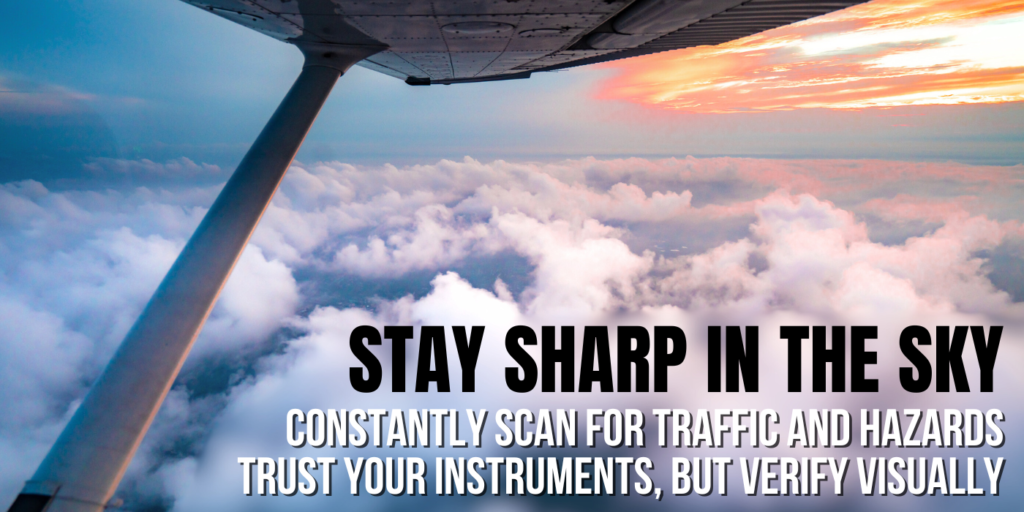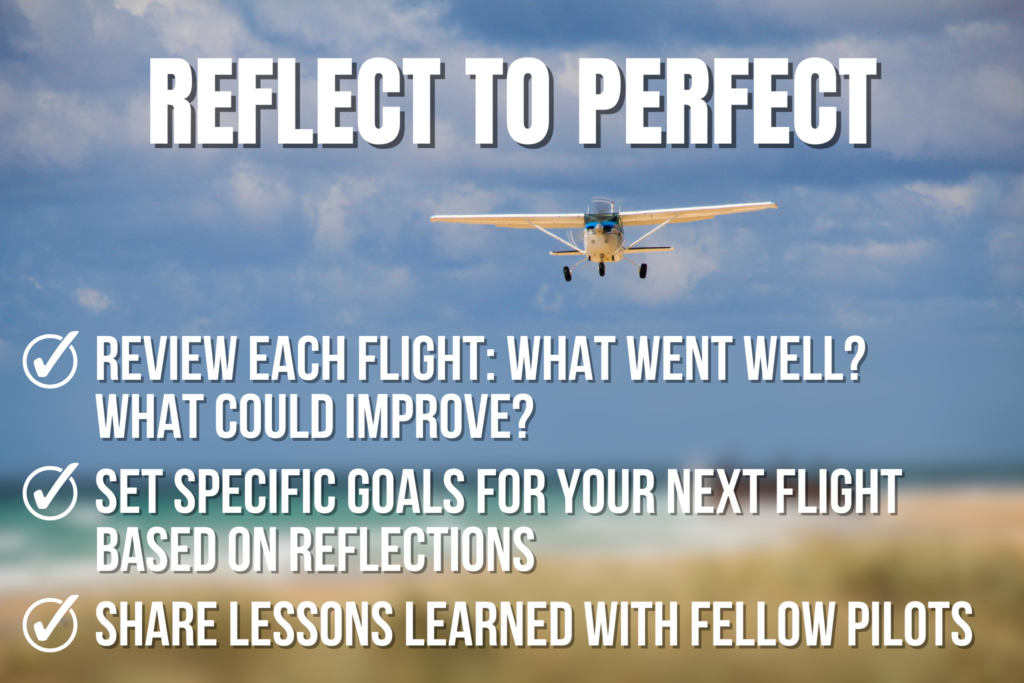Welcome to Week 2 of National Safety Month 2024
Proudly Sponsored by:
Garmin’s certified ADS-B options use the more universally accepted 1090ES technology for ADS-B “Out” and work with your compatible avionics to reliably detect and display ADS-B “In” traffic in your vicinity. That means more awareness — and more value for your rebate — when you go with a Garmin ADS-B installation.
Round 2 of the government ADS-B program is now available. Now is the time to take advantage of the program – and maximise your savings with a Garmin ADS-B solution.
Keeping your head in the game, while your plane’s in the air: a pilot’s guide to inflight situational awareness
As you soar through the skies, maintaining situational awareness is crucial for safe flying. Just like a seasoned lifeguard, keep a vigilant eye on your surroundings—monitor terrain, airspace, and weather changes. Trust your instincts if something feels off and stay updated on fuel and traffic. Remember, flying demands focus, so minimise distractions and prioritise clear communication. With a proactive mindset and the right gear, you can navigate the complexities of the air like a pro.
You’ve done your pre flight checks, you’re up in the wild blue yonder, and now it’s time to keep your situational awareness as attentive as a Bondi lifeguard on a busy summer day. Let’s dive into how to stay switched on when you’re cruising up above.

The 3D chess game of the skies
Flying isn’t just about going from A to B – it’s about navigating a complex 3D maze. Here’s how to play:
- Know your place: Always know where you are in relation to terrain, airspace, and other aircraft. Treat the air around you like a crowded pub – know who’s where, or you might bump into someone.
- Airspace ace: Keep track of airspace boundaries like they’re electric fences. Stumbling into controlled airspace unannounced is about as welcome as a fox in a chicken coop.
- Terrain tracker: Scan the ground like you’re hunting for a lost thong at the beach. The Great Dividing Range won’t sidestep for you. Good sunnies help spot mountains and missing footwear alike – both save you from a nasty surprise.
Weather or not, here we come
In airspace as large as ours, it important to realise how varied and at times unpredictable our weather can be. Stay ahead of it:
- Sky scanner: Keep your eyes on the sky like it’s the latest footy match. That build-up to the west might be planning an ambush faster than a drop bear. Quality sunglasses aren’t just for looking good – they’ll help you spot weather changes early.
- ATIS addict: Check weather updates more often than your social media. ATIS or for that matter an AWIS or AERIS are your inflight influencers; pay attention to what they’re saying. A noise cancelling headset will help you catch every word, even when the engine’s grumbling.
- Escape artist: Always have an out. Know your alternate aerodromes like the back of your hand. If the weather turns, you’ll have yourself to thank.
Refuel rumba
Running out of fuel is about as fun as finding a redback in your boots. Stay on top of it:
- Fuel detective: Know your fuel state better than you know your favourite pub’s happy hour times.
- Math maestro: Keep recalculating your fuel burn and range. It’s the only math that might save your life. A clear head helps with calculations, so make sure your headset fits comfortably for those long flights.
- Suspicious mind: If the numbers don’t add up, don’t pull an Elvis and say “suspicious minds.” divert and fill up. Better on the ground wishing you were in the air than the other way around.
Traffic tango
The sky might be big, but it can get crowded. Here’s how to avoid stepping on toes:
- Ears on: Listen to radio chatter like it’s the hottest goss at the local. That Jabiru 5 miles out might be your new dance partner. A good headset is worth its weight in gold here; you don’t want to miss a call because your ears are ringing.
- Eyes out Scan the air like a bargain hunter at the Boxing Day sales: quick, thorough, and not missing a single opportunity. Your sunnies should be clean and scratch-free; you don’t want to mistake a bug smear for that approaching traffic.
- Proactive pilot: If you spot traffic, don’t wait for a formal introduction. Take action early to maintain separation.
The intuition insight
Sometimes, your intuition is your best instrument:
- Trust your gut: If something doesn’t feel right, it likely isn’t. Your subconscious may pick up on subtle cues; like a slight change in engine pitch or an unexpected weather pattern.
- Speak up: If you’re uncomfortable, say so. ATC would rather hear your concerns than your mayday call. A clear, static-free radio transmission can make all the difference, so invest in a quality headset.
- Better safe than sorry: Treat potential issues like you would a suspect weather front on the horizon. You wouldn’t fly straight into a wall of dark clouds, so don’t ignore those niggling doubts either. Taking a cautious detour is always better than pushing through and risking a storm.
When the unexpected occurs
Even with the best situational awareness, challenges can arise. Here’s how to handle them:
- Aviate: Your primary focus is flying the aircraft. Maintain control and establish a safe flight configuration before addressing other issues.
- Navigate: Determine your position and the best route to a safe outcome. While GPS is valuable, don’t underestimate the power of basic navigation skills and visual references.
- Communicate: Don’t hesitate to call for assistance. ATC is there to help, not judge. Clear, concise communication is crucial, so ensure your radio equipment is in good working order.
The human factor: You’re the pilot, not the passenger
- Fatigue fighter: Feeling tired? A strong flat white isn’t a substitute for sleep, and your Tecnam isn’t a good place for a kip. Know when to call it a day. A comfortable headset and staying hydrated can reduce fatigue on long flights.
- Stress Management: Leave ground-level concerns on the ground. If you find yourself preoccupied, take a moment to refocus. Remember, your aircraft responds to your inputs, not your worries.
- Maintaining Focus: Develop the concentration of a tennis player at match point. Up here, distraction is a luxury you can’t afford. Utilise your pre-flight routine to get into the right headspace, and use appropriate equipment like noise-cancelling headsets to minimise disruptions.
Remember, situational awareness in flight is like keeping a keen eye on that sizzling barbecue – it needs constant attention or you may get burned. Stay sharp, fly smart, and keep your wits about you from takeoff to touchdown. Your trusty headset and quality sunnies aren’t just kit – they’re your partners in maintaining top-notch situational awareness. Here’s to safe skies and smooth landings!
Post flight reflection: Enhancing safety and proficiency

The plane might be nicely tucked away in the hangar but that doesn’t mean you’ve finished. Post-flight reflection is a crucial practice for pilots to enhance safety and proficiency. By systematically reviewing each flight, pilots can:
- Evaluate decision making and situational awareness
- Assess aircraft handling and communication skills
- Identify areas for improvement and celebrate successes
- Turn insights into actionable steps for future flights
This process fosters continuous learning, improves safety, and contributes to pilot excellence. Making post flight reflection a habit allows pilots to learn from every flying experience and become more prepared, aware aviators.
The importance of post-flight analysis
After completing a flight, it’s tempting to consider the job done once the aircraft is safely on the ground. However, there’s a crucial step that can significantly improve your skills and safety as a pilot: post-flight reflection.
Every flight presents unique challenges and learning opportunities. While pre-flight planning and inflight situational awareness are essential, post flight reflection allows you to assess how effectively you managed those challenges. This process isn’t just about identifying areas for improvement; it’s also about recognising and building upon successes. Regular post-flight reviews can enhance decision-making skills and improve situational awareness, contributing to safer and more efficient future flights.
Conducting an effective post-flight review
- Flight plan adherence: Compare the actual flight path to your planned route. Were there any deviations? If so, what necessitated them, and how did you manage the situation?
- Decision making: Evaluate the decisions made during the flight. Were there instances where you needed to adjust your plan or react quickly? Consider the effectiveness of your choices and their outcomes.
- Situational awareness: Reflect on your level of awareness throughout the flight. Were you consistently aware of your aircraft’s position, fuel state, and surrounding traffic? Were there any distractions or moments where your focus lapsed? How might you maintain better SA in future flights?
- Physical and mental state: Assess your condition during the flight. Did fatigue or stress affect your performance at any point? Consider strategies for better managing your physical and mental state on future flights.
- Emergency preparedness: Review your readiness for potential emergencies. Did you mentally rehearse emergency procedures before take off? How confident do you feel in your ability to handle unexpected situations?
- Communication: Analyse your interactions with ATC, other pilots or your even your CTAF calls to anyone who may have been listening. Were your radio transmissions clear, concise, and professional? Identify any areas where communication could be improved.
- Aircraft handling: Evaluate your proficiency in all phases of flight. Were there any moments where you felt less than fully in control? Consider which areas of your flying technique might benefit from additional practice or training.
Turning reflection into action
The real value of post flight reflection lies in applying the insights gained to your future flights. After your review, consider documenting key lessons and areas for improvement. This might include adjustments to pre-flight planning procedures, skills that require refinement, or equipment that warrants more thorough inspection.
For instance, you might identify the need to:
- Improve fuel planning for flights to remote airports
- Enhance traffic scanning techniques in busy airspace
- Review and practice specific emergency procedures
Its also important to celebrate the wins, like nailing that crosswind landing.
The power of self-assessment
Objective self-assessment is crucial for growth as a pilot. While external factors can contribute to challenges during a flight, taking ownership of your decisions and actions is key to continuous improvement. Regular, honest self-evaluation not only enhances safety but also fosters a mindset of lifelong learning; something that, as pilots we should be committed to.
Your journey to excellence
Post-flight reflection is a valuable opportunity to learn from each flying experience and apply those lessons to future operations. By incorporating this practice into your routine, you can enhance your skills, improve safety, and contribute to a more prepared and aware aviation community.
Human factors for pilots: Situational awareness
Do you really know what’s happening around you? Explore how failing to maintain the “big picture” and thinking ahead can lead to undesirable outcomes.
Safe skies and happy flying!
PARTICIPATE TO WIN!
Read and watch the content above then complete the short quiz to enter our Week 2 prize draw!
YOU COULD WIN ONE OF THE FOLLOWING PRIZES*
FIRST PRIZE: Garmin D2 Air X10 Aviator Smartwatch + FLYTE Sunglasses
Sponsored by Garmin and FLYTE
Valued at $1,120
SECOND PRIZE: iPad 10.9 Inch 64GB + OzRunways Subscription
Sponsored by RAAus and OzRunways
Valued at $1,048
THIRD PRIZE: Garmin D2 Air X10 Aviator Smartwatch
Sponsored by Garmin
Valued at $910



*Applicants must hold a current Flying Membership or Non-Flying Membership in order to win the first prize.
*Terms and Conditions apply

